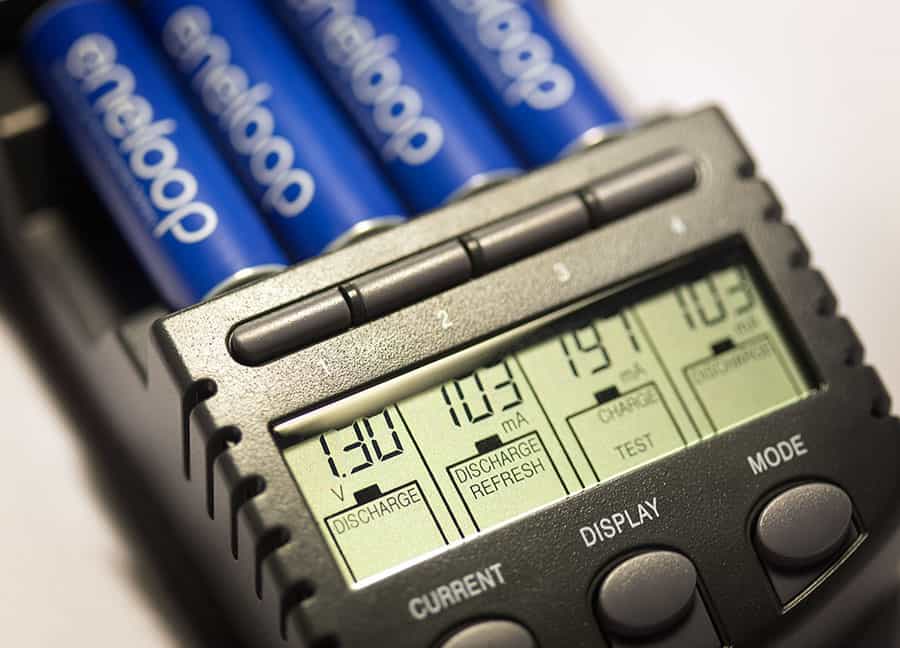
Above: The La Crosse Technology BC1000 allow cell by cell management of the recharging process for AA and AAA batteries. Photo by Mark Lyndersay.
BitDepth#1073 for December 27, 2016
After the excitement of Christmas day and the cooling reality of Boxing day comes the hard realisation that those wonderful devices that you took the time to wrap so deftly will need batteries and if they prove popular, a lot of them too.
After working with batteries for more than 40 years – long before cell phones and pervasive electronic toys – battery technology has never been better than it is today.
But along with those improvements come more energy sources with very different characteristics.
When I first started looking for cost-effective portable electricity, there were standard zinc chloride batteries and now mercifully obsolete nickel-cadmium (NiCad) rechargeables. A choice between low energy and rechargeable cells that had to be nursed along carefully to avoid a memory effect that could rob a user of much of the battery’s capacity.
All that today’s consumer has to guide them in a more diverse market are hopeful advertising claims of “longer life,” “longer lasting” and “more energy.”
Most batteries in use in modern devices are either the marker-pen thick AA size cell or the pencil thin AAA battery.
For most folks, energy source perfection is the low self-discharge formulation introduced to the nickel-metal hydride (NiMh) rechargeable battery market by the Eneloop brand.
These batteries sacrifice high energy discharge for surprisingly long life between charges, unlike typical rechargeable batteries which lose their charge after a full charge with appalling speed.
The technology has been adopted by other brands and Amazon’s Basics brand of batteries are believed to be made using this technology.
The most commonly used battery in use today is the alkaline battery, which offers good energy output and robust shelf life, with recent battery designs boasting a ten-year window of use.
In electronics, alkalines often prove to be problematic. They last only a little longer than a rechargeable battery in high drain devices but have a well-documented tendency to leak and corrode battery compartments if the device is set aside for a long time (I’ve seen leaks in a matter of months of downtime).
You might think it would be obvious that you should take batteries out of an electronic device if you aren’t using it for a while, but it’s easy to simply forget and end up dealing with an unholy mix of gummy acids, noxious powders and badly corroded electric contacts when a device won’t respond.
So in a curious turn, much of my ammunition chest of batteries is divided between low self-discharge rechargeables, high-energy low discharge rechargeables (expensive, fewer recharges total) and old-school heavy duty batteries.
There is now a line of carbon zinc batteries marketed specifically as heavy-duty which are excellent for devices which pull small amounts of current over a long time, such as clocks or electronics that require small amounts of current to perform their functions and are less likely to leak their innards when not in use for extended periods.
They are also excellent for toys which don’t use screens but need a battery to remain operational.
Because I use a lot of batteries for work, powering speedlights for photography and triggers for remote firing, it quickly becomes obvious which ones should be used where in practical day to day use.
For toys and household appliances that need battery power for stand by functions as well as actual use, it may take more time to figure out which one works best for a particular deployment.
If a flashlight (and I highly recommend LED devices, which offer excellent light output for their power draw) is rarely used, then a heavy-duty battery might be a better idea. If it’s being used fairly regularly, perhaps in one of those stick-ons that you put in a dark cupboard, then rechargeables will probably pay off in short order.
Rechargeables require a charging system, and you can get great ones from manufacturers like Maha, but I get nerdy about battery analysis and testing, so I use units from La Crosse Technology, who sell seriously geeky tools that can analyse, discharge and recharge batteries on a cell by cell basis, allowing you to identify which specific battery is performing badly in a set.
The BC1000 charger system ships with four AA and four AAA cells, plastic sleeves that allow you to use AA size rechargeables in devices that require C and D size cells, and offers reliable overcharge and overheat detection.
This may be a long response to the question you asked yourself this morning when you realised you needed hit the grocery to get some batteries, but it’s the cherrypicked fruit of four decades of annoyance with the energy cells we depend on more than ever.


